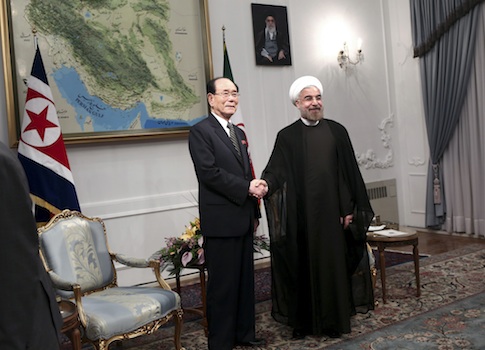
By Ali Alfoneh and Reuel Marc Gerecht
We don’t know all that has transpired in the talks on Iran’s nuclear program being conducted in Switzerland, but we do know that the White House has shied away from a potentially paralyzing issue: the “possible military dimensions” — the PMDs — of the regime’s program. As Olli Heinonen, a former No. 2 at the International Atomic Energy Agency, has warned, outsiders really can have no idea where and how fast the mullahs could build a nuclear weapon unless they know what Iranian engineers have done in the past. Without “go anywhere, anytime” access for IAEA inspectors and a thorough accounting of Tehran’s weaponization research, we will be blind to the clerics’ nuclear capabilities.
And one of the most important issues — probable North Korean nuclear cooperation with the Islamic Republic — deserves special scrutiny. This disturbing partnership casts serious doubt on the Obama administration’s hope that President Hassan Rouhani and his team have any intention of limiting Iran’s nuclear ambitions.
The unfinished North Korean-designed reactor that was destroyed by Israeli planes on Sept. 6, 2007, at Deir al-Zour in Syria was in all likelihood an Iranian project, perhaps one meant to serve as a backup site for Iran’s own nuclear plants. We draw this conclusion because of the timing and the close connection between the two regimes: Deir al-Zour was started around the time Iran’s nuclear facilities were disclosed by an Iranian opposition group in 2002, and the relationship between Shiite-ruled Syria and Shiite Iran has been exceptionally tight since Bashar al-Assad came to power in 2000. We also know — because Ali Akbar Hashemi Rafsanjani, the former Iranian president and majordomo of the political clergy, proudly tells us in his multivolume autobiography — that sensitive Iranian-North Korean military cooperation began in 1989. Rafsanjani’s commentary leaves little doubt that the Iranian-North Korean nexus revolved around two items: ballistic missiles and nuclear-weapons technology.
In his memoirs, the bulk of which is composed of journal entries, Rafsanjani openly discusses Iran’s arms and missile procurement from North Korea. However, from 1989 forward, his entries on Pyongyang become more opaque — a change, we believe, indicating emerging nuclear cooperation. By 1991, Rafsanjani discusses “special and sensitive issues” related to North Korea in entries that are notably different from his candid commentary on tactical ballistic missiles. Rafsanjani mentions summoning Majid Abbaspour, who was the president’s technical adviser on “chemical, biological, radiological, and nuclear industries,” into the discussions. Rafsanjani expresses his interest in importing a “special commodity” from the North Koreans in return for oil shipments to Pyongyang. He insists that Iran gain unspecified “technical know-how.”
The Iranian-North Korean contacts intensify in 1992, the year that Rafsanjani, with Rouhani at his side, launches a policy of commercial engagement with the Europeans. On Jan. 30, Rafsanjani receives intelligence minister Ali Fallahian and Mostafa Pourmohammadi, the ministry’s director of foreign espionage, to discuss “procurement channels for sensitive commodities.” On Feb. 8, Rafsanjani writes, “The North Koreans want oil, but have nothing to give in return but the special commodity. We, too, are inclined to solve their problem.” Rafsanjani orders defense minister Akbar Torkan to organize a task force to analyze the risks and benefits of receiving the “special commodity.” This task force recommends that the president accept the “risk of procuring the commodities in question.” Rafsanjani adds that “I discussed [this] with the Leader [Ayatollah Ali Khamenei] in more general terms and it was decided to take action based on the [task force’s] review.”
It’s most unlikely that the “special commodity” and the technical know-how surrounding it have anything to do with ballistic missiles; Rafsanjani expresses anxiety that the “special commodity” could be intercepted by the United States, but doesn’t share this worry about missile procurement. In a March 9, 1992, journal entry, the cleric gloats about the U.S. Navy having tracked a North Korean ship bound for Syria but not two ships destined for Iran. Two days later, when the “special commodity” is unloaded, he writes: “The Americans were really embarrassed.”
Odds are high that even today the Central Intelligence Agency doesn’t know what Rafsanjani got from Pyongyang, but it is safe to surmise that the North Koreans weren’t clandestinely building a peaceful nuclear reactor at Deir al-Zour . CIA Director John Brennan has often asserted that U.S. intelligence doesn’t believe that the clerical regime is on the verge of making atomic weapons, and he further claimed that Langley could detect any Iranian decision to sneak toward the bomb. But Washington hasn’t guessed correctly once since World War II about the timing of nuclear weaponization by foreign powers (the A-bombs of close allies Britain and France don’t count). Odds are good that North Korea helped to jump-start Iran’s nuclear-weapons program. If so, how long did this nefarious partnership continue?
Rouhani was Rafsanjani’s alter ego. He’s undoubtedly the right man to answer all of the PMD questions that the IAEA keeps asking and the Obama administration keeps avoiding.
Washington Post

Leave a Reply
You must be logged in to post a comment.